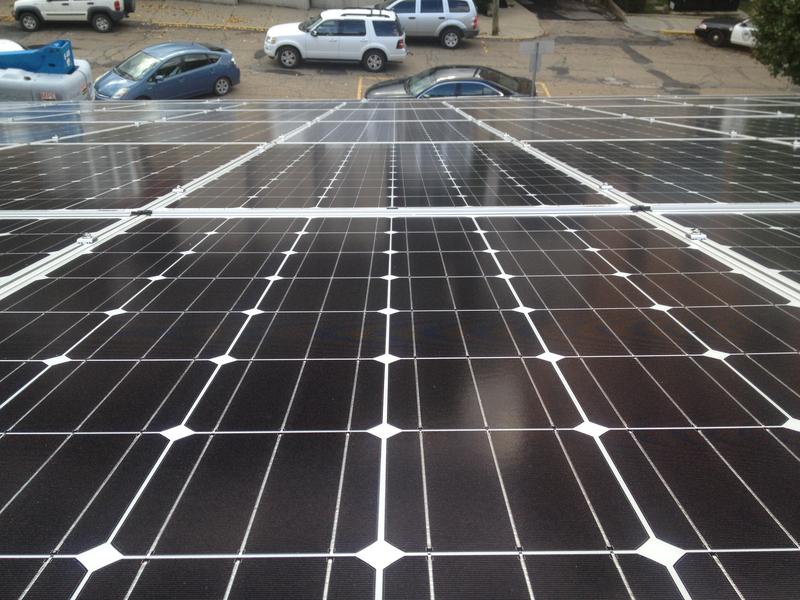Why Coal Country May Be Going Solar
4:33 minutes

 This segment is part of The State of Science, a series featuring science stories from public radio stations across the United States. This story by Brittany Patterson originally appeared on West Virginia Public Broadcasting.
This segment is part of The State of Science, a series featuring science stories from public radio stations across the United States. This story by Brittany Patterson originally appeared on West Virginia Public Broadcasting.
Lawmakers in the West Virginia Senate have passed a bill that would markedly increase solar generation in the coal-heavy Mountain State.
More than 50% of electricity generated in West Virginia came from coal in 2018.
S.B. 583 creates a utility solar program. Under the bill, the state’s two power generators, American Electric Power and FirstEnergy, could each install up to 200 megawatts of solar capacity, in 50 megawatt increments, potentially creating a 5,000% increase in the state’s installed solar capacity.
The bill passed the upper chamber Friday, 31-0, with three members absent. It now heads to the House, where a version of the bill introduced in that chamber sparked considerable debate in the House Energy Committee.
The West Virginia Commerce Department requested the bipartisan bill. Officials there said West Virginia’s lack of solar energy is a detriment to attracting some new businesses to the state, as increasingly large companies require access to renewable energy to meet corporate sustainability targets.
If fully implemented, the bill could expand West Virginia’s installed solar exponentially. According to the Solar Energy Industries Association, West Virginia has just over 8 megawatts of installed solar through the third quarter of 2019, and ranked 48th in the nation in installed capacity.
“History is being made today,” said Sen. Randy Smith, a Republican from Tucker County, on the Senate floor Friday. “I believe this is the first solar bill ever brought forth on the Senate floor, and I can guarantee it’s the first one ever brought forth by a coal miner.”
Under the bill, utilities will be able to concurrently recover the costs of installing the solar through a rate increase approved by the Public Service Commission. PSC Chair Charlotte Lane previously told lawmakers residents can expect to pay about 18 cents per month to cover the cost.
“West Virginia needs to be known as the energy state.”
Once 85% of each 50 megawatt block of solar is purchased or claimed, ratepayers would begin to see the surcharge decrease, she said.
The proposal drew sharp criticism from some lawmakers from energy-rich regions of the state. Lobby group the West Virginia Coal Association is opposed to the measure.
On the Senate flood Friday, Sen. Charles Clements, a Republican from natural gas-rich Wetzel County, tried to temper fears that expanding solar development in West Virginia threatens fossil fuels.
“Many of today’s companies are going green and demand a different product than coal or natural gas. We have been blessed in West Virginia with an abundance of those natural resources and we continue to sell those into the market,” he said. “We need to add solar to our inventory of products that we sell. West Virginia needs to be known as the energy state.”
Some solar advocates have also expressed concerns.They worry the utility solar bill lacks consumer protections and consolidates control of future renewable energy development with utility companies. They are pushing instead for legislative action to legalize third-party solar development, or purchase power agreements, which are currently illegal in the state. They argue that would make rooftop solar more accessible to citizens, nonprofits and small businesses.
Some lawmakers who have pushed expanding solar policy in West Virginia see the utility solar bill as an opportunity to demystify some of the fear around solar.
Del. Evan Hansen, a Democrat from Monongalia County and environmental scientist, said while the bill is not perfect, creating a utility program is a good first step.
“I think that if we pass the solar bill, it’s very likely that within a year or so there will be a large customer that demands solar electricity and brings business to West Virginia,” Hansen said, speaking after an event earlier this month co-hosted by the West Virginia Center on Climate Change in Charleston. “And even if we could just see one success story like that, where there’s a real company that comes to West Virginia because they require renewables, it’ll really open up people’s minds who just can’t conceive of it now. That’s why I’m confident that we’ll be able to build on it step by step. We just have to show some results.”
Correction: a previous version of this story stated that the state would increase solar capacity by 2,500%. That is incorrect—the correct number is 5,000%. We regret the error.
Invest in quality science journalism by making a donation to Science Friday.
Brittany Patterson is a Energy and Environment reporter at West Virginia Public Broadcasting in Morgantown, West Virginia.
Katie Feather is a former SciFri producer and the proud mother of two cats, Charleigh and Sadie.
Ira Flatow is the founder and host of Science Friday. His green thumb has revived many an office plant at death’s door.